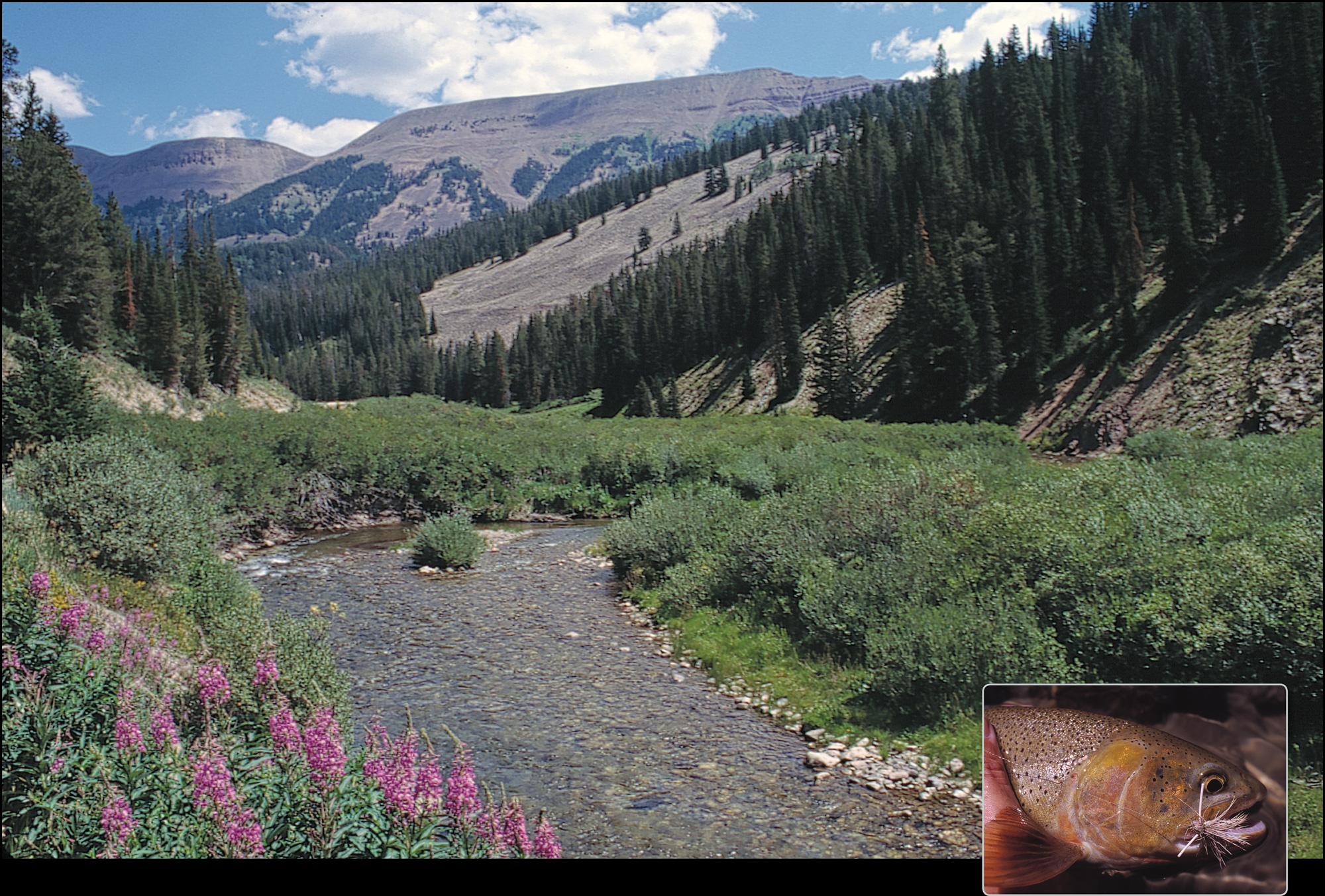
24 Jul The Headwaters to Wyoming’s Wild Cutthroat Paradise
Exploring the backroads of the Tri-Basin Divide
ATOP THE 8,680-FOOT HIGH Tri-Basin Divide, life was good. Depending on the prevailing winds, rain from puffy cumulous clouds above could drop into any one of the three watersheds below us, each sheltering its own variety of cutthroat trout. The Tri-Basin vicinity is a unique piece of the West’s bio-geography: It’s arguably the best place in the world for anglers to tempt three distinct types of native cutts, living within a few miles of each other.
My wife, Mary, and I were beginning a backroads cutthroat safari through southwest Wyoming. To the north, the headwaters of the beautiful Greys River dropped sharply off the divide, slicing a deep path between the Wyoming and Salt River Ranges. Heading to the Pacific Ocean via the Snake and Columbia Rivers, the Greys remains a stronghold for Snake River fine spotted cutthroats.
South of where we stood, LaBarge Creek begins its journey to the Green and Colorado Rivers, toward the Gulf of California. LaBarge and other streams draining the east face of the Wyoming Range support the best remaining populations of Colorado River cutthroats in the state. Along the way, as we discovered, LaBarge is bisected by the rutted remnants of the 19th century Lander Cutoff of the Oregon Trail.
West of our perch, the upper reaches of the Smiths Fork River wind to the Bear River and Great Basin. The watershed shelters some of the most robust remaining enclaves of Bonneville cutthroats, a fish many biologists thought was extinct until it was “rediscovered” in the 1970s.
Given the riches spread out below us, the main challenge we faced was deciding which drainage to explore first.
Greys River: Chasing Snake River Cutts
BOUNCING DOWN THE TRI-CENTER DIVIDE into the upper Greys watershed, Mary and I gazed beyond the narrow dirt road at a tumbling mountain stream, framed by brilliant blooms of paintbrush, fireweed, and 11,363-foot Wyoming Peak, the highest point in the basin.
The river’s name was inspired by a half-Iroquois fur trapper, John Grey, who also went by the tongue-tangling name of Ignace Hatchiorauquasha. Grey explored the area between 1816 and 1840, and helped break Britain’s hold on the fur trade, eventually resulting in the establishment of the Oregon Territory by Congress in 1848. As Mary and I would see later, this sprawling addition to the United States would leave lasting marks on the historical landscape of the Tri-Basin area.
Near the diminutive headwaters, the Forest Service has placed a roadside sign: “Greys River — Watch Me Grow.” And grow it does, quickly gathering itself into a fishable creek, expanding to a medium-sized river, then exploding into the brawling cataracts of Snaggle Tooth Rapids in its lower reaches. Over the course of 60 miles, the Greys presents an enticing array of angling opportunities, eventually playing out where it slides into Palisades Reservoir on the South Fork of the Snake River. It remains the longest undammed stream in Wyoming.
Running through the Bridger-Teton National Forest for virtually its entire length, the Greys River affords exceptional access and camping. Because of all the public land, the Greys offers an increasingly rare phenomenon — an intact Western river valley devoid of billboards, burger joints, miniature golf, or other hints of “civilization.”
On our summer sojourn, Mary and I enjoyed numerous altercations with wild Greys cutthroats, which rose from the depths to inspect, suspiciously nudge, and often inhale our hopper patterns with the unguarded joie de vivre these comely beasts are known for. We encountered miles of diverse, New Zealand-clear water, fished in comparative solitude; the experience was like drifting back 50 years in a pleasant fly-fishing dream.
According to Wyoming Game and Fish Department (WGFD) biologist, Rob Gipson, more than 95 percent of the Greys’ trout population is comprised of wild, native Snake River fine spotted cutthroats; the cutts are competing well with the small number of exotic trout in the river, benefitting from the many spawning tributaries. Since stocking of rainbows ended, there are few of them left in the Greys, a good sign given the propensity of cutts to lose the competition battle to non-native trout. The odd bow, brown, or brookie turns up periodically, but everything we caught displayed distinctive cutt markings.
Like the two other native Tri-Basin trout, the Snake River fine spotted cutt (Oncorhynchus clarki behnkei) is scientifically classified as a “minor” subspecies of the Yellowstone cutthroat. Indigenous to west-central Wyoming and a small piece of southeast Idaho, the fine spotted cutt is named after the well-known fisheries biologist, Dr. Robert Behnke. According to Behnke (Trout and Salmon of North America, 2002), major drainages in the trout’s present range include the South Fork of the Snake and tributaries like the Hoback, Gros Ventre, Salt and Greys River.
The Greys is a wild, free-stone river, with a trout population affected by all of nature’s extremes, including drought, low winter flows, and a powerful spring runoff as the snowpack roars out of the high country. Consequently, says Gipson, the trout population is generally measured in the hundreds-per-mile, rather than the thousands you might find on dam-controlled tailwaters like the Bighorn, Beaverhead or Snake. This is a different, arguably more natural fishing experience.
Like the other Tri-Basin cutthroats, Greys’ denizens tend to be opportunistic feeders, not hatch-specific Einsteins. Cutts are suckers for attractor dry patterns — bring Turck’s Tarantulas, Chernobyl Ants, Madame Xs, Humpies, Wulffs, Renegades, Stimulators, and Trudes and you’ll likely be off to the races. These fish don’t mind looking up for their next meal. Then again, a beefy stonefly nymph bounced along fast, boulder-strewn bottoms isn’t a bad choice, either.
Mary and I were working a creek-sized side channel on the lower Greys. Cumulonimbus clouds with bruised, purplish underbellies were building over the Salt River Range. “We’re going to get pummeled,” Mary announced after studying the deteriorating sky: “I’m heading back to camp,” she said, reeling in. I acknowledged that was the smart move, but true to my headstrong form — and no surprise to her — I decided to stay, as the clouds gathered ominously.
After Mary’s retreat, I appropriated her prime spot, and plunked my hopper/dropper enticements below a half-submerged root wad in the side channel, where the current had scoured a deep hole. A torpedo-shaped creature immediately rose from the depths, flashed open its white mouth, and grabbed the hopper. I reared back to set the hook, which promptly popped out of the fish’s closing jaws. In nearly the same instant the dropper nymph caught the fish’s tail as it headed back down; the cutt panicked, leaving a large wake and my reel screaming as it streaked out of the side channel into much heavier water in the main river.
Fifty feet downstream was a long stretch of rapids where the trout would easily pilfer my backing, unless I could quickly stumble through the boulders after it. Even though it was foul hooked, I was able to turn the fish before it hit the whitewater, and managed to work it back in to the mouth of the side channel. I removed the bead and took a moment to admire an 18-inch cutt, a prize on the Greys. Then it eased back toward its root wad home, as lightning flashed around the peaks and the first large raindrops dimpled the water. It was time for me to head back too.
LaBarge Creek: Reliving History, Reviving Colorado River Cutthroats
NEAR THE TRI-BASIN DIVIDE, the historic Lander Cutoff of the Oregon Trail traverses the high country along upper LaBarge Creek.
The first federally financed road west of the Mississippi River, the 256-mile Cutoff was constructed from South Pass, Wyo., to Fort Hall, Idaho. The Cutoff shaved 100 miles off the route to the Oregon Territory and California gold fields; 13,000 settlers and 79,000 livestock passed through in 1859, the first year it was open. Lush, creek-side grass at LaBarge Meadows along the Divide provided abundant forage for weary stock, and the last good camping spot before travelers pushed over more mountains to the west.
It was a tough trip, as the scattered, poignant old graves attest. While it is impossible to know precisely how many perished on the Oregon Trail, one estimate holds that one out of every 17 travelers died along the way, leaving an average of one grave every quarter mile along the wagon trail. In spite of the hardships, the early pioneers passing along upper LaBarge Creek had the opportunity to partake of a sublime landscape, abundant game, and a stream teaming with tasty Colorado River cutthroats.
LaBarge Creek rises along the southern flanks of the Salt River and Wyoming ranges in the Bridger-Teton National Forest, running southeast for approximately 50 miles. LaBarge offers a near-perfect small stream template, exceptionally serpentine, with a variety of water types.
The creek was christened after a colorful French-Canadian — Joseph Marie LaBarge — an ancestor of Pulitzer-prize winning Wyoming author, Annie Proulx. LaBarge was born in 1787 in L’Assomption, Quebec, which he left at the age of 21, alone in a birch bark canoe. He made his way past Montreal, up the Ottawa River, through various connecting waterways in Ontario, across the Great Lakes, and along the Fox, Wisconsin, and Mississippi Rivers to reach St. Louis in 1808. His original canoe still intact, LaBarge only needed to portage eight miles during his entire journey. But LaBarge’s travels were just starting: He headed west to the outer reaches of Wyoming in the 1820s to trap beaver and leave his name on an exquisite trout stream.
Wyoming was a really wild place in the early 19th century, but LaBarge would likely not find his namesake creek radically altered today. In its upper reaches, above 8,000 feet, numerous mountain tributaries feed LaBarge Creek, snaking through forested glades, beaver ponds, and open meadows. The landscape becomes more arid downstream, scattered pines giving way to fragrant sage, crimson and tan rock strata slicing dramatically across the valley at odd angles. South of the national forest boundary, the creek runs through public Bureau of Land Management (BLM) property, then threads through private ranches lower down. Its wild, captivating course ends where it enters the Green River, between the small energy town of La Barge and Names Hill, a sandstone cliff where Oregon Trail travelers carved their signatures for posterity.
Today, LaBarge Creek supports a diverse trout population, including newly restored Colorado River cutthroats in its upper reaches. In recent years, the creek has been the focus of a major cooperative project to restore its native cutthroats, which had been pushed into the headwaters and tributaries by brook trout, and threatened with hybridization by rainbows. The LaBarge project is the largest fish restoration project ever attempted in Wyoming.
The Colorado River cutthroat (Oncorhynchus clarki pleuriticus) is the only cutt subspecies indigenous to the upper Colorado River watershed, with an original distribution that spanned southwest Wyoming, western Colorado, east-central Utah, northwest New Mexico, and extreme northeastern Arizona. Today, the fish occupies only about 5 percent of its original range. According to Behnke, approximately 100 genetically pure populations of Colorado cutts remain in the West, mostly in short, remote headwater reaches. The WGFD reports that the fish currently occupies just 13 percent of its original Cowboy State range.
Colorado cutts have been adversely affected by the same factors as other cutthroats in the West: hybridization with introduced rainbows, competition from non-native brook trout, overharvest, and harmful agricultural and mining practices. In 1999, a coalition of environmental groups petitioned the US Fish and Wildlife Service to list the Colorado River cutthroat under the federal Endangered Species Act (ESA). To date, the trout has not been listed, although it is a Wyoming sensitive species and the state is actively working to restore it.
According to Hilda Sexauer, WGFD Regional Fisheries Supervisor in Pinedale, LaBarge Creek hadn’t been stocked with non-native trout since 1990, but they had largely taken over when the cutthroat project started. The main focus of the restoration effort has been upstream from the forest service boundary, where a small dam was constructed in 2002 to prevent further upstream migrations of exotic trout. Above the barrier, non-natives were successfully removed with chemical treatments. Beginning in 2007, the upper creek was restocked with thousands of genetically pure cutts, both fingerlings and catchable-size fish, including some sizeable specimens. The goal is to end stocking once the population is self-sustaining.
Sexauer says that prior to the restoration effort, the densest fish concentrations in LaBarge were in upper meadow reaches, which once held up to 1,900 brook trout per mile. Now that the brookies have been replaced by cutts, Sexauer suspects there ultimately may be fewer trout in these stretches, but they will likely be larger: “Brook trout overpopulate — cutthroats are less likely to stunt themselves.”
On our 2009 trip to LaBarge, I hooked feisty cutts in the creek’s upper reaches on an increasingly chewed-up Humpy. Based on my unscientific hook-and-line survey, the cutts are hungry and thriving in their “new” home.
LaBarge Creek retains a diversity of angling options. According to Sexauer, LaBarge offers a “unique opportunity to catch Colorado River cutthroat in their native range,” while still allowing anglers to seek rainbows, browns, brookies and the occasional cutt below the barrier. Sexauer speculates that retention of these alternatives is one reason there was relatively little opposition to the restoration plan.
This is rugged, geologically complex country, rippled with energy-rich thrust faults and folds. In their book, Roadside Geology of Wyoming (1991), David Lageson and Darwin Spearing observed, “For the geologist, this part of Wyoming is a paradise of structural intrigue and stratigraphic variation; nothing seems constant or uniform.” One consistent theme, however, has been growing interest in developing the oil and gas resources in western Wyoming’s Overthrust Belt, which includes the Tri-Basin region.
Several years ago, a diverse, bipartisan effort to protect the Wyoming Range’s cutthroats and prolific wildlife from energy development was organized by local ranchers, outfitters, anglers, hunters, and others under the umbrella group, Sportsmen for the Wyoming Range. Their quixotic, grassroots efforts actually succeeded in early 2009 when the Wyoming Range Legacy Act passed Congress, part of a larger public lands bill subsequently signed by President Obama. The legislation protects 1.2 million acres of the Wyoming Range from future oil and gas development, and includes a provision for buying back energy leases that have already been issued. As the bill’s sponsor, U.S. Senator John Barrasso (R-WY), said, “I strongly support oil and gas development in our state, but I also believe some places are simply too special to develop.”
My mind’s floating back to a perfect summer morning, camped on LaBarge Creek with Mary. As the sun hit the valley floor and rapidly removed the night’s chill, we took a refreshing dip in the icy stream. On a distant ridge, under a cobalt sky, a family of coyotes yipped and howled like mad beatniks; we were the only people around for miles. With the return of its native fish, LaBarge Creek is gradually getting wilder, more like it was when Joseph LaBarge etched his name on the Wyoming map and the Oregon Trail pioneers passed through.
Smith Fork River: Bonnevilles And Wyoming’s Weirdest Watershed
AFTER LaBARGE CREEK, Mary had to return home, so I was left to my own devices exploring the Smiths Fork of the Bear River, the missing link in the triumvirate of regional cutthroat drainages. Predictably my journey was off to a shaky start.
Across the Smiths Fork, a guy with a gray ponytail was leaning on the fence gate, squinting menacingly into the sun and scrutinizing my movements. He was standing in front of the only inhabited dwelling for miles, a mobile home perched on the stream bank; pickup trucks were scattered about and barking dogs warily patrolled the perimeter. So far, I hadn’t detected any weapons. But the scene resembled the kind of “compound” that made the news some years ago when the Freemen stood off against the FBI in Jordan, Mont.
I had been wandering up the isolated river in pursuit of illusive Bonneville cutthroats. The map showed a BLM parcel next to the river, and it looked like the perfect place to camp and launch fishing sorties. But as I cased the place, it was obvious from this guy’s body language that we needed to visit. As I walked over, I figured I’d get chewed out and run off for trespassing.
“Hi, I’m Mick, but my friends call me ‘Puddin’ Pie,’” he said, grinning and extending his hand. Behind him, I detected two such friends, naked and cavorting wildly in the river. After explaining what I was up to, he said “Come on in, Jeff, let me introduce you.”
Puddin’ Pie cajoled his buddies out of the water to shake hands; they turned out to be his brother Don and their mutual friend Bill, who toweled off and pulled on a tie-dyed T-shirt dazzling enough to attract hummingbirds. Later, Dennis would show up, another member of the posse who was a local ranch hand, looking like a grizzled cowpoke who just sauntered out of a John Ford western. It turned out that Puddin’ Pie and friends leased the riverside patch from a rancher and visited during the summer for fishing and carousing, and again in the fall for hunting and more misbehavior.
“I was watching and could tell you were looking for that BLM piece,” said Puddin’ Pie. “Make yourself at home over there — and once you get settled in, stop back around five for beer and some supper.” My excursion along the Tri-Basin Divide had already been blessed with aspects of serendipity — like a great college road trip — and I was pleased to see the trend continue. The Smiths Fork was the last place in the world I expected a party and dinner invitation. Mix in the prospect of 15- to 20-inch Bonneville cutthroats and life in wild Wyoming can be really good.
The Smiths Fork rises off the southern tail of the 10,000-foot high Salt River Range. On its way down from the Tri-Basin Divide, the Smiths Fork pulls in water from tributaries such as Hobble Creek, becoming a modestly-sized, moderately fast river that’s easy to wade but not float. Heavily timbered in its mountainous, national forest upper reaches, the Smiths Fork gradually cuts a path through rolling, sage and aspen-covered hills, forming a broad ranching valley by the time it enters the Bear River, near Cokeville, Wyo.
It is difficult to fathom the quirky Smiths Fork fishery without pondering the Bear River, a 500-mile long, convoluted oddity. The Bear is the longest river in the Western Hemisphere that never touches an ocean, Wyoming’s only watershed that is part of the Great Basin. This fugitive river nervously jumps state lines five times: It rises in Utah’s High Uintas Wilderness, sneaks north into Wyoming, escapes back to Utah, briefly reenters Wyoming again to capture the Smiths Fork, then veers west into Idaho. Finally, it changes its mind once more and loops south back to Utah, ending in the Great Salt Lake 70 miles from where it originally started its confusing journey.
The drainage was once immersed by glacial Lake Bonneville, which swelled to nearly the size of Lake Michigan, inundating the current site of Salt Lake City in more than 1,000 feet of water. Lake Bonneville was the ancestral home of the Bonneville cutthroat (Oncorhynchus clarki utah). The lake nearly vanished 8,000 years ago following the last Ice Age, leaving the Great Salt Lake and nearby Utah Lake as remnants. Long after Lake Bonneville’s demise, its cutts continued to survive mainly in headwater reaches of their namesake basin and a few lakes, scattered through portions of southwest Wyoming, southeast Idaho, western Utah, and northeastern Nevada.
More than a century ago, settlers south of Salt Lake City commercially netted enormous Bonneville cutthroats up to 40 pounds in Utah Lake. At the time, the fish was a vital food source for both Native Americans and Mormon pioneers. By the 1930s, however, the cutthroats had vanished from the lake, and genetically pure Bonnevilles were thought to be extinct throughout their range by the 1950s.
In 1974, a federal biologist in Utah’s Deep Creek Mountains discovered a pure population of Bonnevilles: The trout had endured since the last Ice Age, but just barely survived the 20th century. Bonnevilles have been petitioned for federal ESA listing, but to date these efforts have been denied, in part because the states where they reside have been actively working on conserving and restoring them. Fortunately, Bonnevilles persisted under the radar in secluded southwest Wyoming, and the Smiths Fork is one of the best places to catch them.
According to Behnke, fluvial Bonnevilles residing in the Bear River drainage have “a long evolutionary history of existence in semi-arid watersheds subjected to great environmental extremes of floods, droughts, and high sediment loads.” Trout Unlimited’s Warren Colyer has conducted research on Bonnevilles and verifies their tenacity: He found instances where the fish survived daytime water temperatures in the low 80s, often lethal conditions for other trout. While the upper Smith Fork drainage is largely pristine, the Bear River can run warm and muddy, where surprisingly large Bonnevilles coexist in an unlikely fashion with carp, fattening up on bait fish.
Recent studies underscore the importance of the Bear River for cutthroats utilizing the Smiths Fork, and vice versa. Colyer says many of the largest cutts spend the winter in the Bear River before leaving for their spring spawning run. As a graduate student, he employed radio telemetry to track the salmon-like Bonnevilles traveling more than 50 miles into the upper Smiths Fork drainage, near the Tri-Basin Divide.
In part because of its highly interconnected fishery, a proposal for a new dam on the Smiths Fork has raised concerns. Colyer believes a dam would be seriously detrimental to the Bonnevilles: Aside from interfering with migrations, a dam could alter the hydrology of the system, making the stretch below a new reservoir colder, less turbid, and more conducive to rainbows, which haven’t yet gained a solid foothold in the watershed. Ultimately, says Colyer, “the Smiths Fork is really the lynch pin for the central Bear River system.”
A singular feature of the Smiths Fork Watershed is Lake Alice, which feeds Hobble Creek in the upper drainage. Three miles long, 200-feet deep, the lake is tucked at 7,800 feet and accessible only by trail. Lake Alice is a significant and unusual fishery, holding a native population of lake dwelling Bonnevilles. Aside from the strain of Bonnevilles remaining in Bear Lake on the Utah-Idaho border, all other indigenous, lacustrine populations of this fish are extinct.
Lake Alice formed millennia ago when a massive landslide tore down Lake Mountain and dammed Poker Creek, which now gushes out in a giant spring below the mile-long barrier. The abundant cutthroats residing above the slide have access to various spawning tributaries that nourish the lake, sustaining their population.
The evening before my planned hike to Alice Lake, I visited with an old Utah cowboy in the next campsite at the Hobble Creek Campground. He had just hiked down with his young grandson, who was thrilled to have caught a 16-incher. This gentleman had fished Lake Alice for decades, and recounted fond memories of previous trips, fueling my own enthusiasm. But he was exhausted, conceding this would be his final hike to the lake. Nonetheless, he looked me in the eye, smiled, and said, “It’s a good life my friend, it’s a good life.”
The next morning at Lake Alice, I was excited to find a calm, glassy surface, broken only by rising Bonnevilles. In the clear water it was easy to spot cutts patrolling the shoreline, within easy casting distance.
I tied on a Parachute Adams, with a gray mayfly spinner as a dropper. I studied the cruising fish, trying to predict where they were headed, then lead them with my cast. Each trout had its own beat, but would make random and infuriatingly unpredictable turns, perhaps an instinct designed to fool predators. After a couple hours I had caught many pretty Bonnevilles keying on a subtle spinner fall, ranging up to15 inches.
The next day, the action continued downstream on the main Smiths Fork. I slapped a bushy Stimulator down next to the willowy bank; the bug danced enticingly along the current seam when a large snout broke the surface to intercept it. The fish battled like a bulldog with anger management issues, shaking his head furiously as he ran deeply along the cobbled bottom. I suspected a good brown, but when I slid it into the shallows for release, pseudo Jack the Ripper slashes adorned its throat — a radiant, 19-inch Bonneville.
My trip around the Tri-Basin Divide was winding down. Based on my reading of the changing sky, a storm was easing in, and the road out could get slick. At my campsite along the Smiths Fork, in the shade of the cottonwoods across from Puddin’ Pie’s gang, I took a nap in the afternoon heat — dreaming about all the nice cutthroats I had caught.
After waking, I pulled out a bottle of Kentucky bourbon and headed over to the compound. To compensate for her absence, Mary had given me a bottle of delectable Woodford Reserve, a replacement campfire companion. This seemed like the place to inaugurate it.
Dennis was cooking a delicious stew, with generous portions of a pronghorn he had bagged. In the twilight, we scanned the slopes for deer and elk easing out of cover to feed, and looked for late rises on the river. Swallows swished overhead, picking off remnants from the evening hatch. Great stories were reprised, many beers were drained, and by the time the night was over, my fresh bottle of bourbon was also dry. Puddin’ Pie slapped me on the shoulder and said, “Erickson, if you come back next year, make sure Mary gives you a bigger bottle of Woodford Reserve.”
Hours later, head full of beer and bourbon, I ambled back to my camp, stars blazing through scattered clouds drifting over the isolated Smiths Fork valley. Polaris, the North Star, pointed my way out the next day. Like the Lake Alice cowboy attested, it’s a damn good life, chasing native cutts around Wyoming’s wild Tri-Basin Divide.
- Beautiful LaBarge Creek rises along the southern flanks of the Salt River and Wyoming Ranges in the Bridger-Teton National Forest, running southeast for approximately 50 miles toward the Green River. • Inset: The Colorado River cutthroat is the only cutt subspecies native to the upper Colorado River watershed, with an original distribution that spanned southwest Wyoming, western Colorado, east-central Utah, northwest New Mexico, and extreme northeastern Arizona. Wyoming Range streams — including a restored reach of LaBarge Creek — remain a stronghold.
- The remote Smiths Fork River winds through a mix of BLM, Forest Service, state and private land. The river offers critical habitat for Bonneville cutthroats, along with brown trout. • Inset: Smiths Fork tributaries like Hobble Creek offer prime water for Bonneville cutthroats, and are important spawning destinations for fish from the lower watershed.
- Map Illustration by Daphne Gillam
- The lower Greys River near the mouth of the Little Greys — a major tributary — is a popular stretch and offers large, varied water. Paralleled by a Forest Service road and surrounded by public land, the Greys offers extraordinary accessibility, in a relativey remote setting. • Inset: Although the Greys River generally doesn’t fish as a hatch-specific river, caddis are relatively abundant.
- The historic Lander Cutoff of the Oregon Trail traverses the high country along upper LaBarge Creek, near the Tri-Basin Divide. The route is strewn with the poignant graves of pioneers who perished during their journey west. • Center: Introduced trout species like rainbows have harmed native cutthroat populations through hybridization and competition for food and habitat.
- Left: The upper Smiths Fork river offers attractive public water, fringed by willows and broken by beaver dams. • Right: Nestled at an elevation of 7,800 feet, Lake Alice was formed by an enormous landslide thousands of years ago, the lake is accessible via a 1-½ mile hike from the Hobble Creek campground.




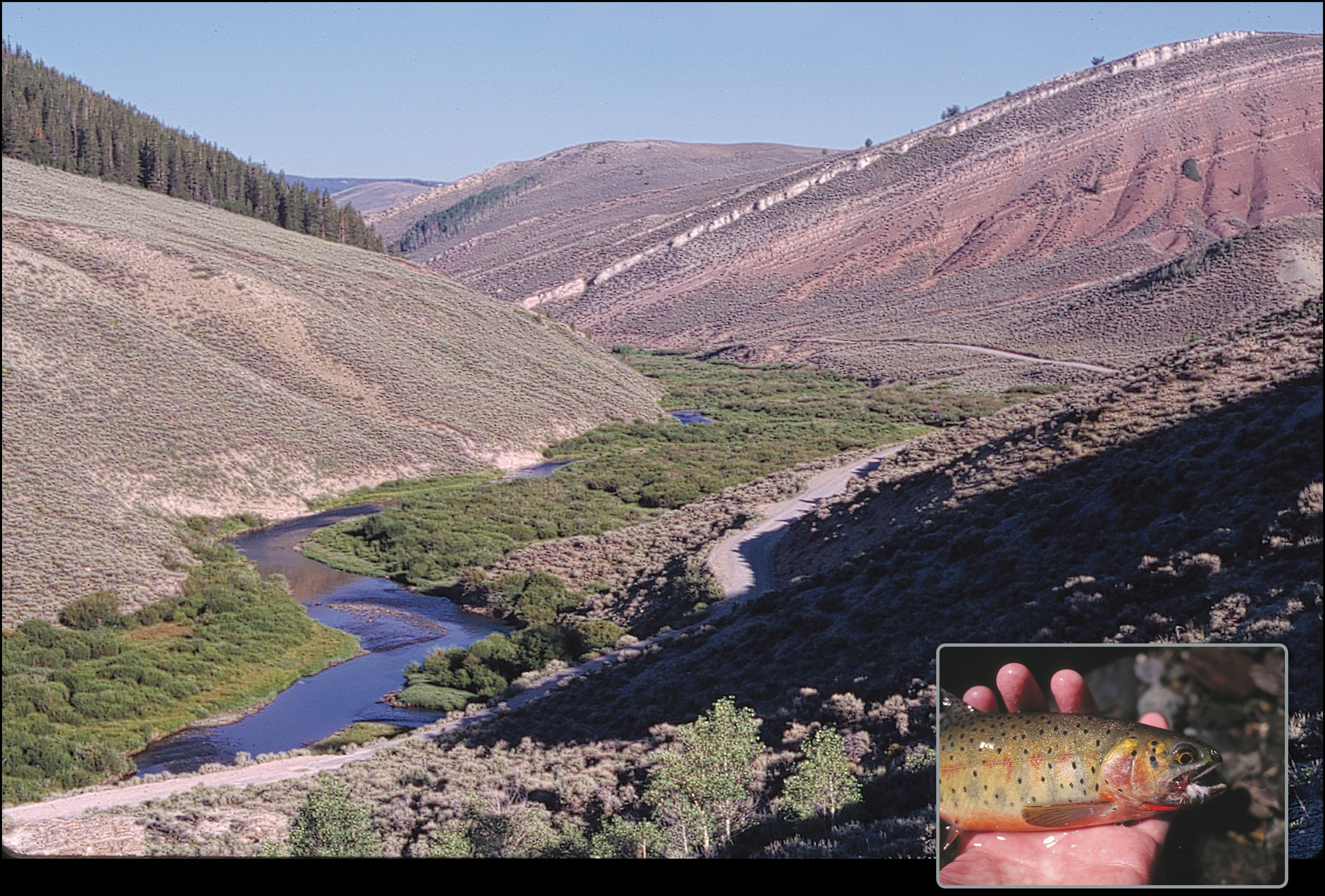
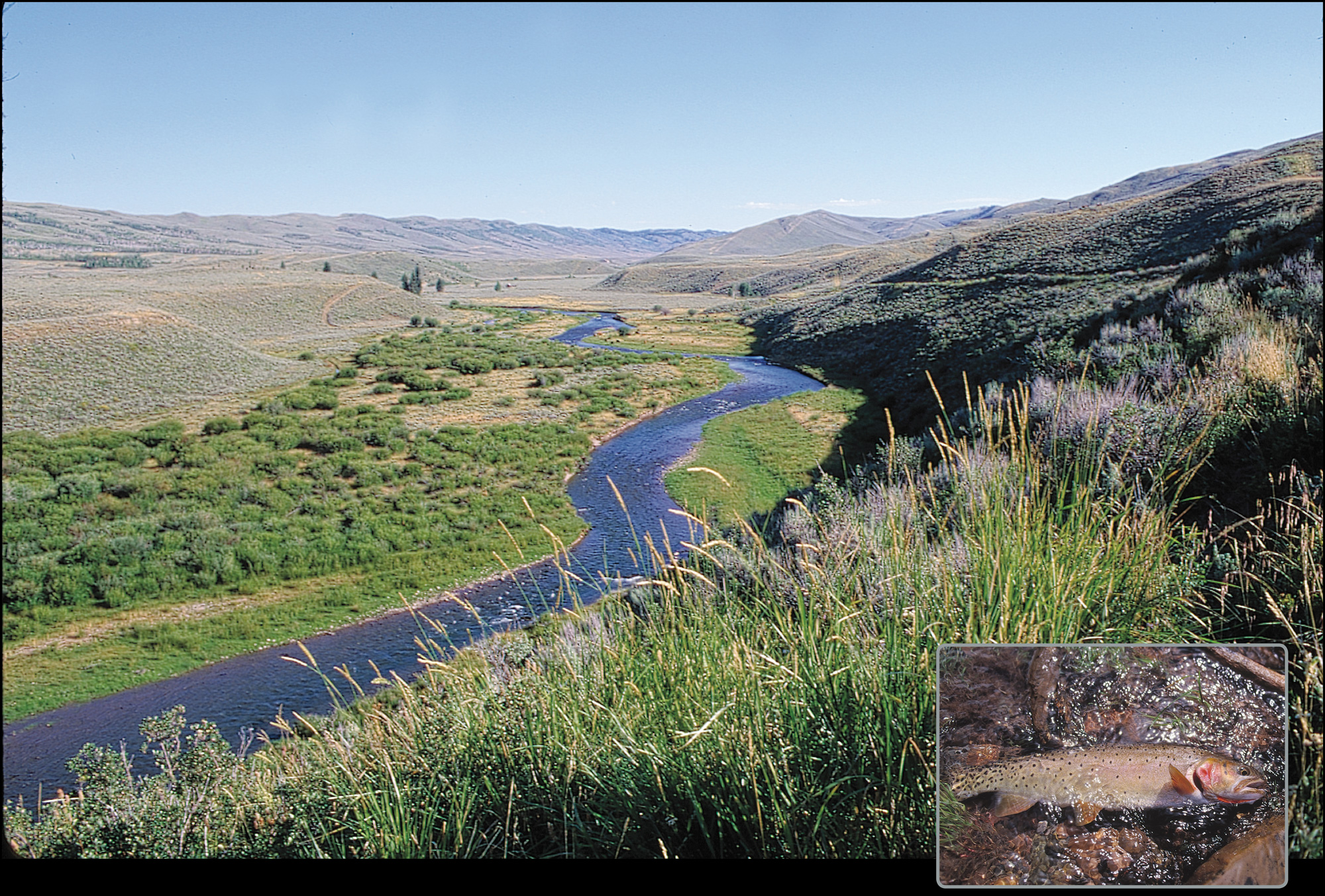
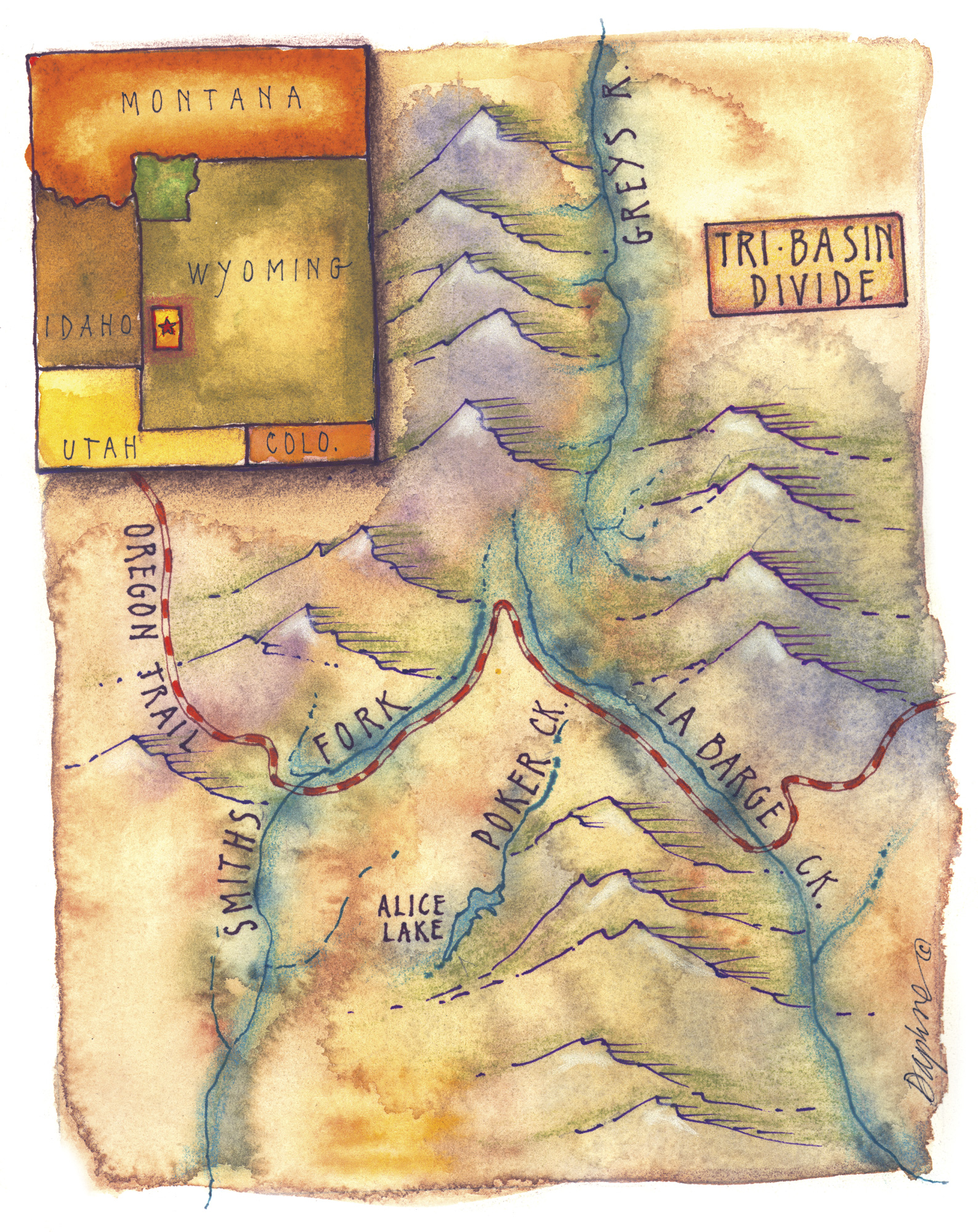
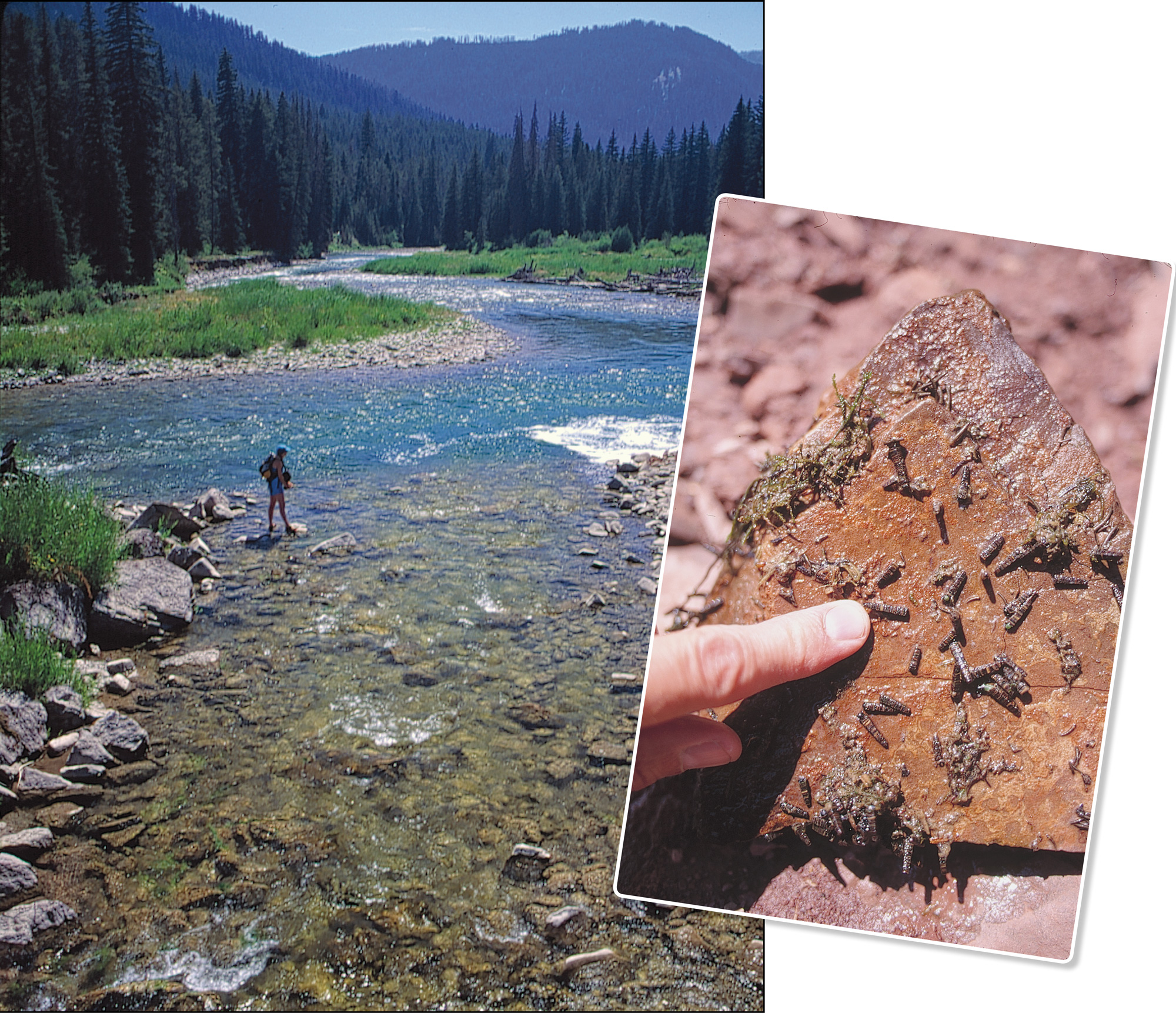
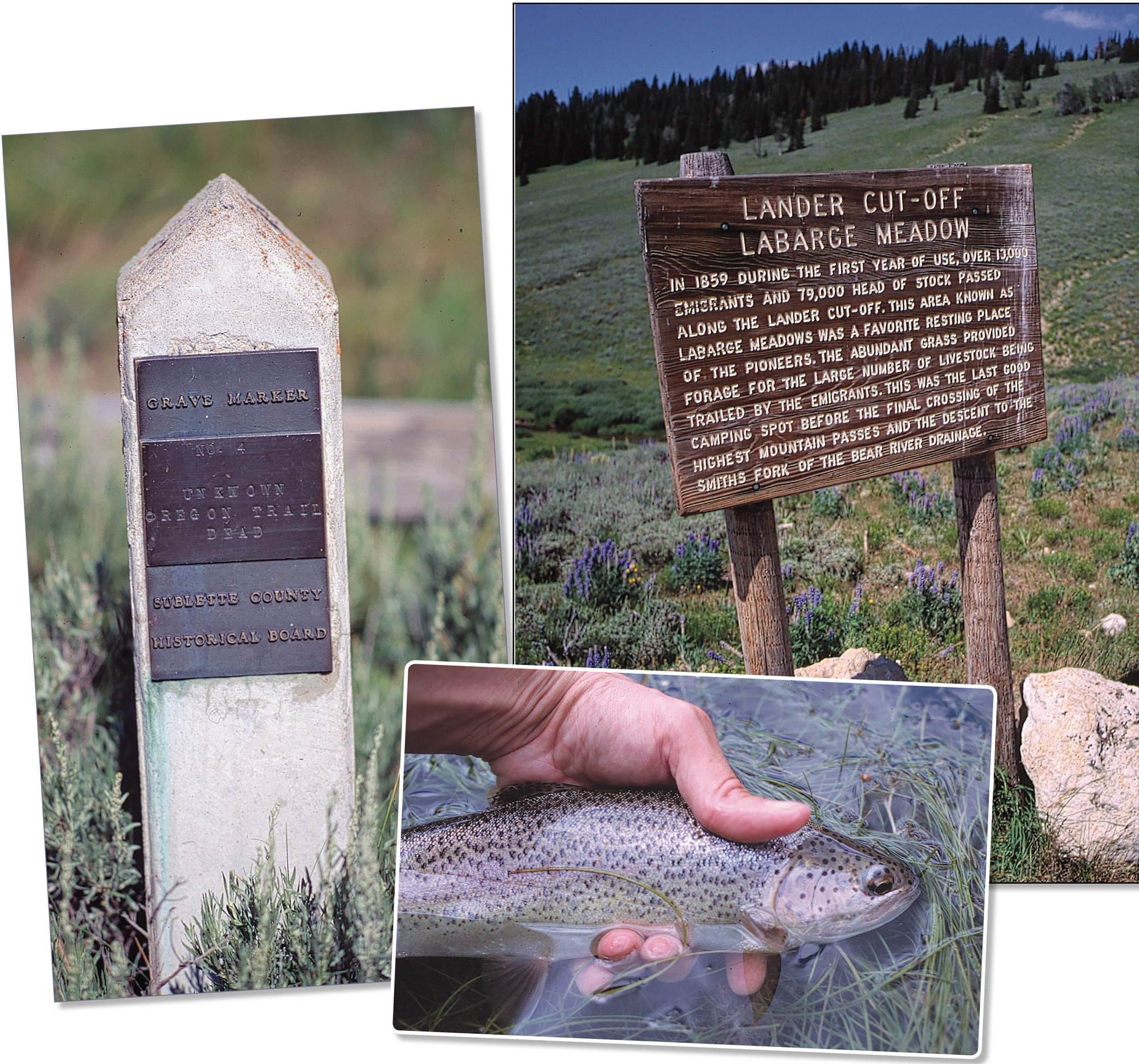

Gerald L. Young, MD
Posted at 23:32h, 14 AugustWho was Smith’s Fork named for and was the namesake a member of the Lewis & Clark Expedition?
Dave Wheelock
Posted at 02:59h, 14 SeptemberMr. Erickson,
What a pleasant surprise to run across your 2010 story in The Big Sky Journal about exploring the waters of Wyoming’s Tri-Basin Divide, even as my Joanne and I eye our first trip up that way from New Mexico. I found your piece well-researched and entertainingly-written.
I wonder if you have been back to the Divide since those days, and how the wild character of the rivers and their surroundings has fared in the years between. We wouldn’t reach those mountains until the second half of September but hopefully conditions won’t be too wintry by then!
Cheers,
Dave Wheelock
Santa Fe